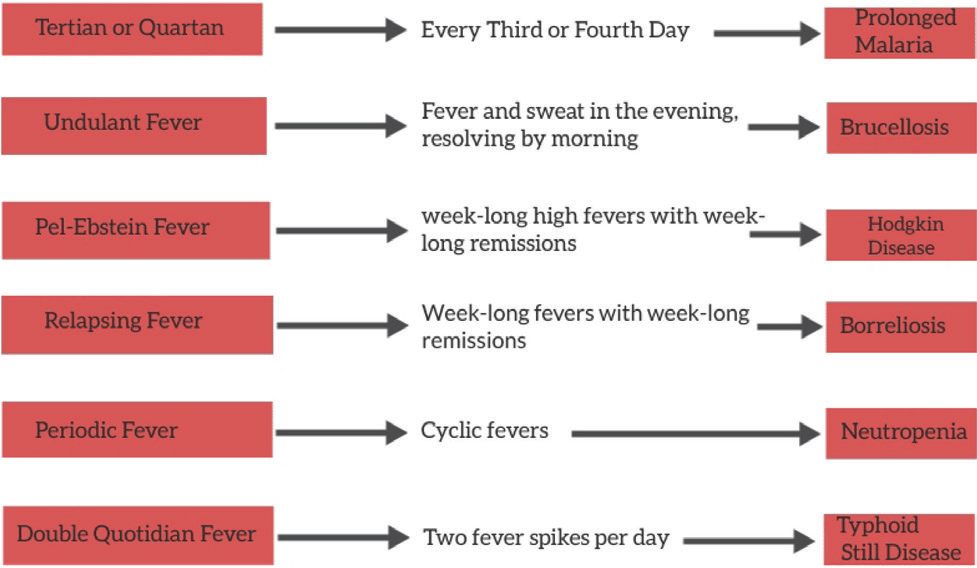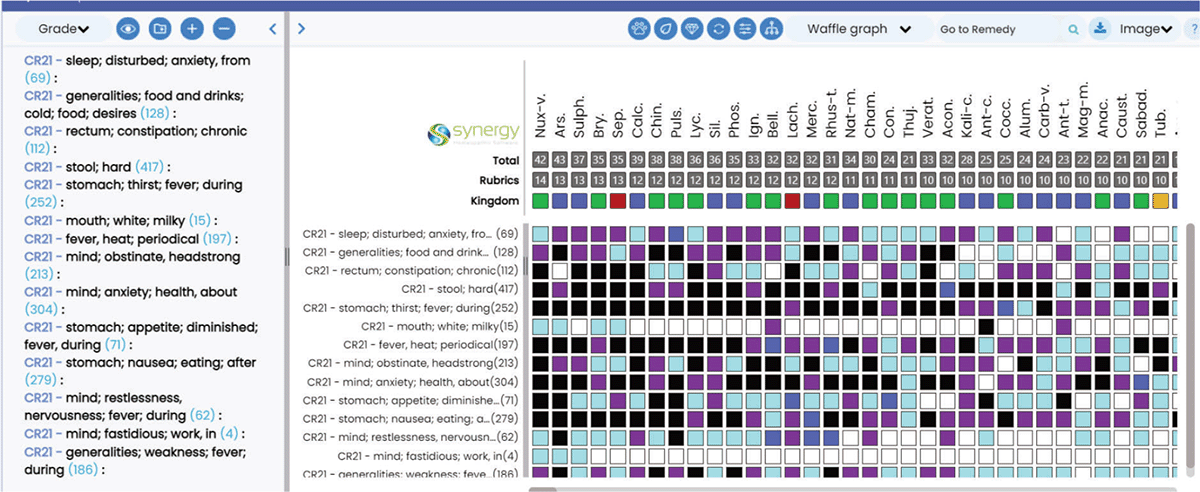
Integrative Medicine Case Reports, Volume 5, Issue 1 (January), 2024
A challenging case of pyrexia of unknown origin: the consequences of homeopathy intervention
KEY WORDS |
ABSTRACT |
|
PUO
|
Pyrexia is the most common symptom that is presented by a disease. It is of the utmost significance to diagnose the cause of a fever. An inaccurate or delayed diagnosis can pose significant risks to the patient’s health. In this article, we present a 32-year-old male with a continuous fever, loss of appetite, and other constitutional symptoms. Every month, between the fifteenth and twentieth days, fever occurs. The diagnosis remained elusive despite numerous investigations. It is also important to understand the different presentations of fevers. For a successful diagnosis, it is critical to take a thorough medical history, identify the fever pattern, perform a systemic examination, and evaluate the patient through proper investigations. The report also discusses different homeopathic remedies that can help with the treatment of such fevers. In cases of PUO, it is best to start with a symptomatic approach to identify the most similar remedy.
doi: 10.38205/imcr.050135 |
|
*Corresponding Author:
|
Introduction
The initially identified occurrence of pyrexia of ambiguous cause was reported in 1961. The term “pyrexia of unknown origin” (PUO) refers to a temperature of 101 degrees Fahrenheit or higher that persists for a minimum of three weeks without a definitive diagnosis despite investigations and admissions (1). As years passed, the PUO was further classified as Classic PUO (the most frequent observed), Nosomial PUO (related to drugs and healthcare), Neutropenic PUO (triggered by neutropenic deficiency) and HIV-related PUO (due to acute illnesses) (2).
Case Presentation
A 32-year-old male from India visited the OPD complaining of continuous fever for the preceding six months. His socio-
demographic data revealed that he was self-employed, from an urban joint family and had a post graduate degree.
STEP 1: Patient’s medical history
According to the patient, his problem manifested suddenly without any apparent cause. The patient started complaining that the constant high temperature was reaching almost 102°F–103°F. The heat was particularly intense in his palms, feet, and head. Alongside this, he experienced tremendous weakness and exhaustion, especially during work. Despite being on medication and taking high-strength anti-febrile tablets every two to three hours, his body had ceased reacting to them.
Step 2: Identify fever pattern
The fever comes every month between the 15th and 20th days. An understanding of different fever patterns is essential, They are (Figure 1):

Figure 1: Fever Patterning.
STEP 3: Examination and Investigations
A physical examination is key to any diagnosis. Look for systemic changes in the heart (murmurs, irregular heart sounds, and tachycardia), lungs (wheeze, rhonchi, and pleural rub), abdomen (splenomegaly, hepatomegaly), lymph nodes, skin rashes, and neurological reflexes (3).
On initial examination, he had tachycardia (100 beats per minute) and was febrile (102°F) with a blood pressure of 110/70 mm Hg. In systemic examinations, the cardiovascular, respiratory, GIT, and nervous systems were examined, and the findings were normal. The tongue had a milky white coat.
A comprehensive metabolic panel, analysis of urine with a microscope and culture, erythrocyte sedimentation rate (ESR), and C-reactive protein (CRP) is standard points of departure for investigations (4).
The findings of every investigation, including the white blood cell count, liver function tests, and C-reactive protein, were normal. Results from the Widal test and malaria parasites were both negative.
Blood cultures (3 sets), Chest X-ray, serum creatinine, rheumatoid factor, tuberculin skin test, HIV immunoassay, CT abdomen and chest, and cardiac echocardiography. When all these investigations come up inconclusive, It is determined that the fever is pyrexia with an unidentified cause. The diagnosis is still uncertain despite the fact that he has had practically every relevant investigation, including the bone marrow biopsy, considered to be the most advanced investigation.
STEP 4: Mental and personal history
His traits include being stubborn, always getting his way, having a great desire to travel, being fastidious about keeping things tidy, experiencing mental suffering, and worrying about his health.
Appetite – loss of appetite, nauseating feeling, after food, there is no desire to eat.
Diet– vegetarian
Thirst – craving cold water during fever
Urine – normal
Stool – constipated, he has to strain a lot
Desire – cold things
Aversion – not specific
Thermals Reaction – chilly +++
Perspiration – Not specific
Sleep – He was anxious about his health, which was making it difficult for him to go asleep.
STEP 5: Treatment and Dosage
Important rubrics and repertories should be considered for homeopathic treatment.
Rubrics: (Figure 2)
CR21 – sleep; disturbed; anxiety, from (69)
CR21 – generalities; food and drinks; cold; food; desires (128)
CR21 – rectum; constipation; chronic (112)
CR21 – stool; hard (417)
CR21 – stomach; thirst; fever; during (252)
CR21 – mouth; white; milky (15)
CR21 – fever, heat; periodical (197)
CR21 – mind; obstinate, headstrong (213)
CR21 – mind; anxiety; health, about (304)
CR21 – stomach; appetite; diminished; fever, during (71)
CR21 – stomach; nausea; eating; after (279)
CR21 – mind; restlessness, nervousness; fever; during (62)
CR21 – mind; fastidious; work, in (4)
CR21 – generalities; weakness; fever; during (186)
Repertorization:

Figure 2: Repertorization Sheet.
Prescription:
Nux vomica 200 BD × 3 Days.
Reason for dosage: High symptom similarity has high susceptibility and that requires high dosage
Sac lac for 7 days.
For symptomatic treatments, clinically relevant remedies can be used, like:
Aconite: High temperatures, agitation, and intense demands require plenty of water. Face flushed due to the strong wind exposure. It is often administered early on as well.
Belladonna: No thirst, flushed the cheeks, a high temperature, and want for solitude. Carotid throbbing and a headache fever caused on by activity or sunlight exposure.
Arsenic album: Fever and restlessness constitute some of the symptoms. Weakness and genuflecting frequently drink small amounts of water. Extremely strong rigors and chills, with a feeling that the blood circulates like ice water. The patient feels like their blood vessels are being filled with boiling water during the heating stage.
Bryonia: A dry cough and fever, along with a widespread physical ache. Does not want to speak to anyone and wants to lie still. A constant need for enormous quantities of water.
Gelsemium: Aching starting at the nape of the neck, darkened face, and flushed countenance. The patient prefers to lay down quietly and has no desire to drink.
STEP 6: Follow ups (Table 1)
Table 1: Follow up schedule.
| 1 | Low-grade fever
Temp: 99 F The patient feels better, yet weakness is still there. |
Sac Lac
For A 7 Days |
| 2 | No major complaint. Fever is not there, but still, weakness is present.
Appetite has not increased much. |
Sac Lac
For 7 Days |
| 3 | No family history or genetic history presents any disease.
Reduced weakness and significantly improved appetite Notes: Elimination started. According to Homeopathy Science. |
Sac Lac For
7 Days |
| 4 | Weakness was markedly reduced. Appetite is good. No complaint. | Sac lac for
7 days |
| 5 | No fever, No weakness
Good appetite Mentally good. |
Sac lac for
7 days |
| 6 | Patient is doing well, No fever, No complaint.
No weakness Good appetite. |
Sac lac for
15 days |
| 7 | No Complaint | Stopped treatment |
Once the individual has been deemed cured of PYREXIA OF UNKNOWN ORIGIN (PUO), the course of treatment will end.
Differential diagnosis
The causes of fever of unknown origin (FUO) can be grouped as infectious, non-infectious inflammatory disorders, malignancy, and miscellaneous, which include conditions such as thyrotoxicosis. All the possible causes in these categories that could potentially explain the clinical picture in this case, including rare ones, were considered and excluded following an intensive investigation (5).
Discussion
As we have seen in the case presentation, following these steps when treating a PUO makes the case taking systematic and the treatment coherent. This also helps the physician in the elimination process of fevers. Clinical understanding of fevers helps a homeopathic physician in better understanding of the case subject and in turn improves the process of analysis of case.
Conclusion
The above scenario emphasizes the potential benefits of homeopathy in handling episodes of PUO and sudden unforeseen events. After an appropriate amount of time has passed to rule out self-sustaining fevers, it is nevertheless challenging to figure out PUO despite a high-quality workup. The emergence of methods for molecular diagnostics has made it more feasible for a physician to capitalize on the medical records of the patient to distinguish infections from other medical conditions.
Authors’ contribution
AKJ: Contributed to conception and planned the article. NJ and SS: Implémentation & Design the article. NJ: writing, critical revision and planned the article.
All authors discussed the case report and contributed to the final manuscript, and they also agreed to take responsibility for all elements of it. This ensured that any questions about the accuracy or integrity of any portion of the work were thoroughly investigated and debated.
Informed consent form
Yes.
Source of funding
We have No funding sources.
Conflict of interest
None.
Received Date: 10-07-2023; Revised Date: 06-11-2023
Accepted Date: 14-11-2023
References
1. Beresford RW, Gosbell IB. Pyrexia of unknown origin: causes, investigation and management. Internal Medicine Journal. 2016 Sep;46(9):1011–6.
2. Hayakawa K, Ramasamy B, Chandrasekar PH. Fever of unknown origin: an evidence-based review. The American journal of the medical sciences. 2012 Oct 1;344(4):307–16.
3. Sepkowitz KA. Effect of prophylaxis on the clinical manifestations of AIDS-related opportunistic infections. Clinical infectious diseases. 1998 Apr 1;26(4):806–10.
4. Bleeker-Rovers CP, Vos FJ, de Kleijn EM, Mudde AH, Dofferhoff TS, Richter C, Smilde TJ, Krabbe PF, Oyen WJ, van der Meer JW. A prospective multicenter study on fever of unknown origin: the yield of a structured diagnostic protocol. Medicine. 2007 Jan 1;86(1):26–38.
5. Cunha BA, Lortholary O, Cunha CB. Fever of unknown origin: a clinical approach. The American journal of medicine. 2015 Oct 1;128(10):1138-e1.